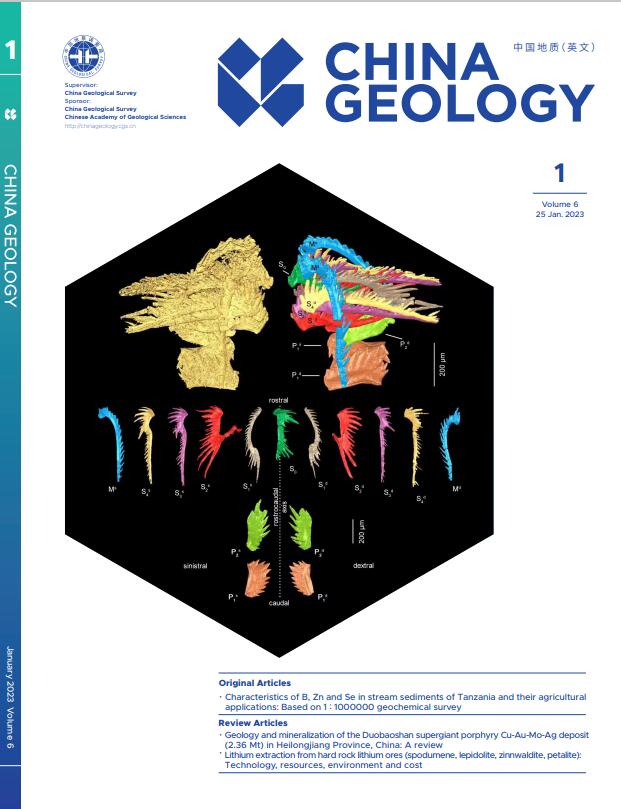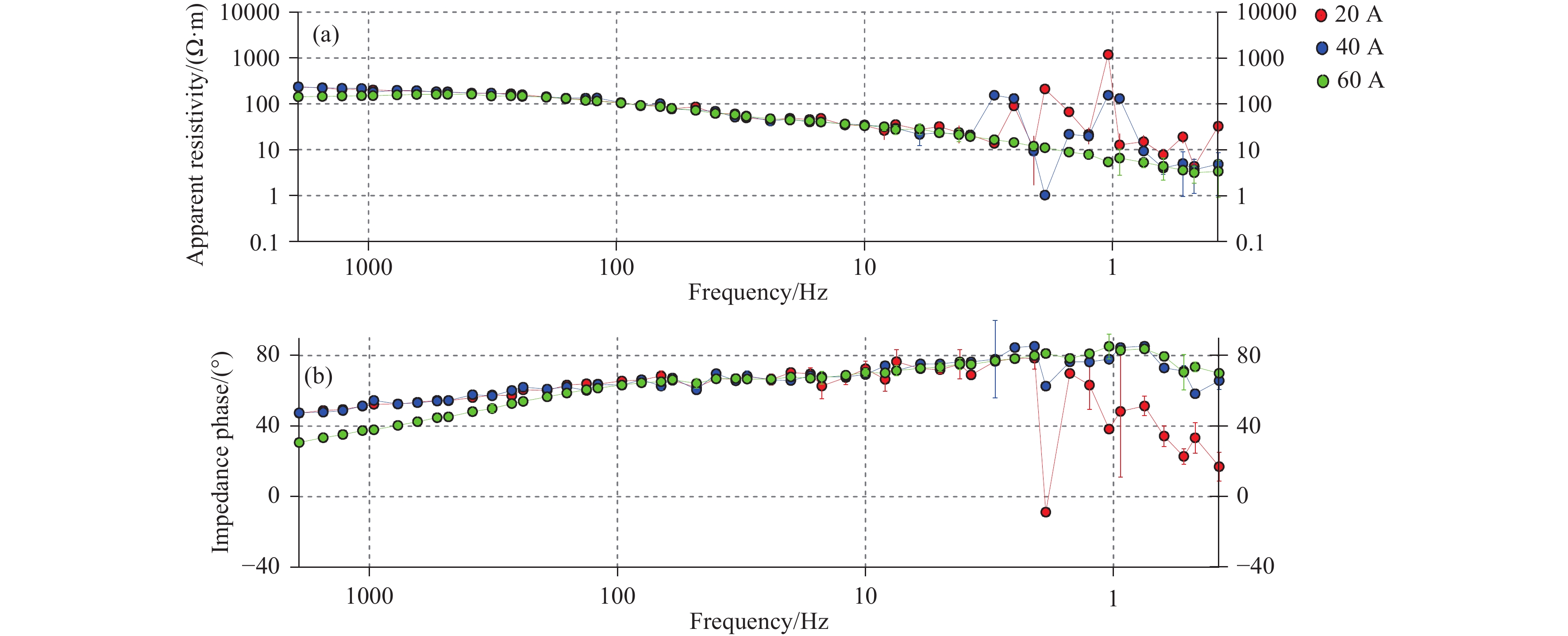| Citation: | Peng-liang Yu, Ting Qu, Ri-zheng He, Jian-li Liu, Su-fen Wang, Xiao-long Chen, 2023. Application of tensor CSAMT with high-power orthogonal signal sources in Jiama porphyry copper deposit, South Xizang, China Geology, 6, 37-49. doi: 10.31035/cg2021065 |
Application of tensor CSAMT with high-power orthogonal signal sources in Jiama porphyry copper deposit, South Xizang
-
Abstract
The Jiama porphyry copper deposit in Xizang is one of the proven supergiant copper deposits in the Qinghai-Xizang Plateau at present, with the reserves of geological resources equivalent to nearly 20×106 t. However, it features wavy and steep terrain, leading to extremely difficult field operation and heavy interference. This study attempts to determine the effects of the tensor controlled-source audio-magnetotellurics (CSAMT) with high-power orthogonal signal sources (also referred to as the high-power tensor CSAMT) when it is applied to the deep geophysical exploration in plateaus with complex terrain and mining areas with strong interference. The test results show that the high current provided by the high-power tensor CSAMT not only greatly improved the signal-to-noise ratio but also guaranteed that effective signals were received in the case of a long transmitter-receiver distance. Meanwhile, the tensor data better described the anisotropy of deep geologic bodies. In addition, the tests also show that when the transmitting current reaches 60 A, it is still guaranteed that strong enough signals can be received in the case of the transmitter-receiver distance of about 25 km, sounding curves show no near field effect, and effective exploration depth can reach 3 km. The 2D inversion results are roughly consistent with drilling results, indicating that the high-power tensor CSAMT can be used to achieve nearly actual characteristics of underground electrical structures. Therefore, this method has great potential for application in deep geophysical exploration in plateaus and mining areas with complex terrain and strong interference, respectively. This study not only serves as important guidance on the prospecting in the Qinghai-Xizang Plateau but also can be used as positive references for deep mineral exploration in other areas.
-

-
References
Boerner DE, Wright JA, Thurlow JG, Reed LE. 1993. Tensor CSAMT studies at the Buchans mine in central Newfoundland. Geophysics, 58(1), 12–19. doi: 10.1016/0148-9062(93)92442-S. Deng QH, Li XB, Pedersen LB. 1993. Magnetotelluric method with controllable source tensor. Translation of Seismogeology, 15(3), 35–42 (in Chinese with English abstract). Di QY, Wang R. 2008. Forward and Inverse Modeling of Controlled Source Audio Magnetotelluric Data and Its Application. Beijing, Science Press, 98−115 (in Chinese). Di Q, Fu C, An Z, Wang R, Wang G, Wang M, Qi S, Liang P. 2020. An application of CSAMT for detecting weak geological structures near the deeply buried long tunnel of the Shijiazhuang-Taiyuan passenger railway line in the Taihang Mountains. Engineering Geology, 268(1), 105517. doi: 10.1016/j.enggeo.2020.105517. Guo Z, Hu L, Liu C, Cao C, Liu R. 2019. Application of the CSAMT method to Pb-Zn mineral deposits: A case study in Jianshui. Minerals, 9(12), 726. doi: 10.3390/min9120726. He JS. 1990. Controlled Source Audio Frequency Magnetotelluric Method. Changsha, Central South University of Technology Press, 25−37 (in Chinese). Huang GY, Zhang GH. 2014. Comparative test of tensor and scalar measurements in known iron ore areas. Geophysical and Geochemical Exploration, 38(6), 1207–1211 (in Chinese with English abstract). doi: 10.11720/wtyht.2014.6.21. Hu YC, Li TL, Fang CS. 2015. 3D tensor CSAMT forward modeling based on vector finite element method. Applied Geophysics, 12(1), 35–46. doi: 10.1007/s11770-014-0469-1. Kouadio KL, Xu Y, Liu CM, Zakaria B. 2020. Two-dimensional inversion of CSAMT data and three-dimensional geological mapping for groundwater exploration in Tongkeng area. Journal of Applied Geophysics, 183, 104204. doi: 10.1016/j.jappgeo.2020.104204. Lei D, Zhang GH, Huang GY. 2014. Application of tensor controlled source audio magnetotelluric method. Journal of Engineering Geophysics, 11(3), 286–294 (in Chinese with English abstract). doi: 10.3969/j.issn.1672-7940.2014.03.003. Li XB, Pedersen LB. 1991. Controlled-source tensor magnetotelluric. Geophysics, 56(9), 1456–1461. doi: 10.1190/1.1443165. Leng FQ, Tang JX, Zheng WB. 2015. Study on ore-controlling factors of thick and large skarn orebody in Jiama porphyry metallogenic system in Xizang. Ore Deposit Geology, 34(2), 273–288 (in Chinese with English abstract). doi: 10.16111/j.0258-7106.2015.02.005. Liu ZX, Xue GQ, Zhang LB. 2017. Comparative analysis of tensor CSAMT effective observation area simulation. Acta Geophysica Sinica, 60(8), 3278–3287 (in Chinese with English abstract). Liu G, Meng X, Tan H, Chen Z, Liu L. 2020. Case study: Joint seismic reflection and CSAMT data interpretation for mineral explorations in Fujian. Acta Geophysica, 68(5), 1–13. doi: 10.1007/s11600-020-00477-2. Meng QK, Ling PR, Xu BL. 2013. One dimensional numerical simulation of tensor CSAMT. Calculation Technology of Geophysical and Geochemical exploration, 35(4), 435–441 (in Chinese with English abstract). doi: 10.3969/j.issn.1001-1749.2013.04.11. Meng QK, Lin PR, Li Y, Li JH, Zhu HW, Li D. 2015. Preliminary study and demonstration of tensor CSAMT data processing technology. Journal of Jilin University (Earth Science Edition), 46(6), 1846–1854 (in Chinese with English abstract). doi: 10.13278/j.cnki.jjuese.201506302. Ma SW, Xu ZQ, Zhang ZK. 2016. Tectonic deformation and its restriction on mineralization of Jiama copper-polymetallic deposit in southern Xizang. Acta Petrologica Sinica, 32(12), 3781–3799 (in Chinese with English abstract). Qu T, He RZ, Yu PL. 2021. Statistics and application of rock physical properties in Jiama mining area, Xizang. Geophysical and Geochemical Exploration, 45(3), 661–668 (in Chinese with English abstract). doi: 10.11720/wtyht.2021.1014. Song L, Wang XW, Tang JX. 2011. From jet genesis to porphyry-skarn metallogenic system, some implications for successful exploration of Jiama copper polymetallic deposit. Ore Deposit Geology, 30(2), 219–230 (in Chinese with English abstract). doi: 10.16111/j.0258-7106.2011.02.005. Tang JT, He JS. 2005. Controlled Source Audio Frequency Magnetotelluric Method and its Application. Changsha, Central South University Press, 57−66 (in Chinese). Tang JX, Wang DH, Wang XW. 2010. Geological characteristics and deposit model of Jiama copper polymetallic deposit in Xizang. Acta Geoscientica, 31(4), 495–506 (in Chinese with English abstract). doi: 10.3975/cagsb.2010.04.02. Tang JX, Deng SL, Zheng WB. 2011. Exploration model of Jiama copper polymetallic deposit in Mozhugongka County, Xizang. Ore Deposit Geology, 30(2), 179−196 (in Chinese with English abstract). 179−196. doi: 10.16111/j.0258-7106.2011.02.002. Tang JX, Zheng WB, Chen YC. 2013. Exploration breakthrough of deep porphyry orebody in Jiama copper-polymetallic deposit, Xizang and its significance. Journal of Jilin University (Earth Science Edition), 43(4), 1100–1110 (in Chinese with English abstract). doi: 10.13278/j.cnki.jjuese.2013.04.018. Wang XX, Di QY, Xu C. 2014. Multi dipole source characteristics and tensor measurement of CSAMT. Acta Geophysica Sinica, 57(2), 651–661 (in Chinese with English abstract). Wang YM, Zhang GH, You M. 2018. Simulating the field source effect of tensor CSAMT method with forward modeling method. Geophysical and Geochemical Exploration Calculation Technology, 40(1), 82–88 (in Chinese with English abstract). doi: 10.3969/j.issn.1001-1749.2018.01.12. Zhong HK, Li L, Zhou HW. 2012. Characteristics of the Nappe tectonic system in Jiama-Kajunguo, Xizang. Acta Geoscientia Sinica, 33(4), 411–423 (in Chinese with English abstract). doi: 10.3975/cagsb.2012.04.03. Zhou YD. 2015. Characteristics and tensor measurement of CSAMT multi dipole sources. Master's thesis, Chengdu, Chengdu University of Technology, 1−99 (in Chinese with English abstract). Zhang ZY, Wang G, Hu XY. 2017. Tensor CSAMT method and comparative experiment. Petroleum Geophysical Exploration, 52(4), 869–874 (in Chinese with English abstract). doi: 10.13810/j.cnki.issn.1000-7210.2017.04.025. -
Access History

-
Figure 1.
Geologic map of the Jiama porphyry copper deposit and the location of research section. a‒geotectonic outline map of Xizang; b‒geologic map of the Jiama porphyry copper deposit (1:50000).
-
Figure 2.
Diagram of measurement range and observation means of tensor CSAMT.
-
Figure 3.
Comparison of test curves in the case of different transmitter-receiver distances.
-
Figure 4.
Comparison of test curves in the case of different emission currents.
-
Figure 5.
Comparison of test curves in the case of different MN electrode spacing.
-
Figure 6.
Comparison of test curves in the case of different observation duration.
-
Figure 7.
Diagram of source and receiving devices of the high-power tensor CSAMT applied in the Jiama porphyry copper deposit..
-
Figure 8.
Histograms for resistivity measurement of main rocks in the Jiama porphyry copper deposit.
-
Figure 9.
Comparison of CSAMT curves collected in the case of different transmitting and receiving directions.
-
Figure 10.
2D inversion results of four sets of high-power tensor CSAMT data along section BB’. a‒EW-direction transmitting and NS-direction receiving; b‒EW-direction transmitting and EW-direction receiving; c‒NS-direction transmitting and NS-direction receiving; d‒NS-direction transmitting and EW-direction receiving.
-
Figure 11.
Comparison of 2D inversion results of tensor CSAMT and MT data of sections AA’ and BB’. a‒2D CSAMT inversion results of section AA’; b‒2D MT inversion results of section AA’; c‒2D CSAMT inversion results of section BB’; d‒2D MT inversion results of section BB’; JMKZ is a scientific borehole with a depth of 3000 m (see Fig. 1 for its location). Vertical variation of resistivity along JMKZ borehole see Fig. 12.
-
Figure 12.
Histogram and curves obtained from core specimen measurement of JMKZ borehole, and inverted resistivity variation across JMKZ from MT and CSAMT of sections AA’ and BB’ in Fig. 11. a‒measured resistivity in JMKZ Borehole; b‒measured polarizability in JMKZ Borehole; c‒inverted 1D CSAMT curve of section AA’; d‒inverted 1D MT curve of section AA’; e‒inverted 1D CSAMT curve of section BB'; f‒inverted 1D MT curve of section BB’. Those location for (c), (d), (e), and (f) see successively (a), (b), (c) and (d) in Fig. 11.





 DownLoad:
DownLoad:










